Post-war use of armored cars and armored personnel carriers created in Nazi Germany
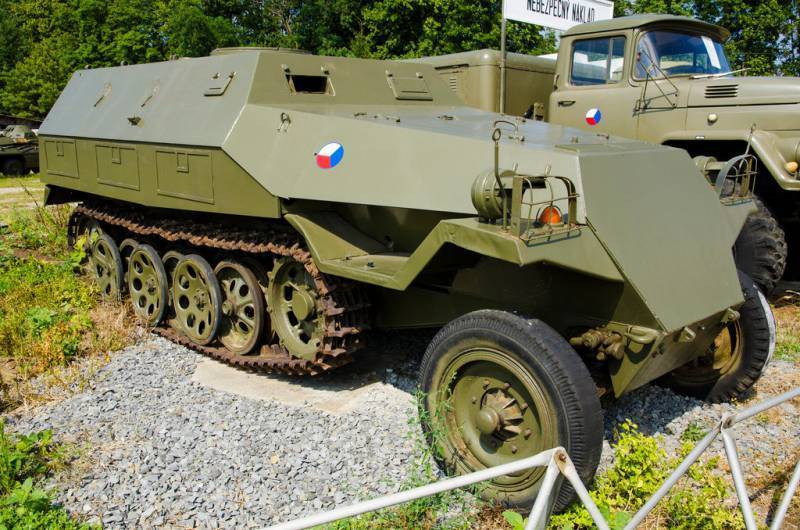
Domestic and foreign sources say a lot about the post-war use tanks and self-propelled artillery units produced in the Third Reich. At the same time, the general Russian reader is very poorly informed regarding the operation of captured German armored vehicles and armored personnel carriers.
This publication will not consider all German armored vehicles that were in service with the Wehrmacht, SS troops and police units, but only those whose post-war use is documented.
Wheeled armored car Sd. Kfz. 222
In 1938, the Wehrmacht entered service with the all-wheel drive two-axle armored car Sd. Kfz. 222 (also designated leichter Panzerspaehwagen (2cm).
This German wheeled armored vehicle, created by the Eisenwerken Weserhütte company, was intended to perform reconnaissance and patrol service and provide communications. By “providing communications” one should understand the delivery of written dispatches; at the first stage, armored vehicles were not equipped with radio stations. However, later on Sd. Kfz. 222 began to install low-power radio stations with a range of about 1 km.
Armored car Sd. Kfz. 222 received a 20-mm automatic cannon 2 cm KwK 30 L/55, with which the MG 34 was paired. Targeting was carried out using the muscular strength of the shooter. It was possible to fire simultaneously from a cannon and a machine gun or from only one barrel.
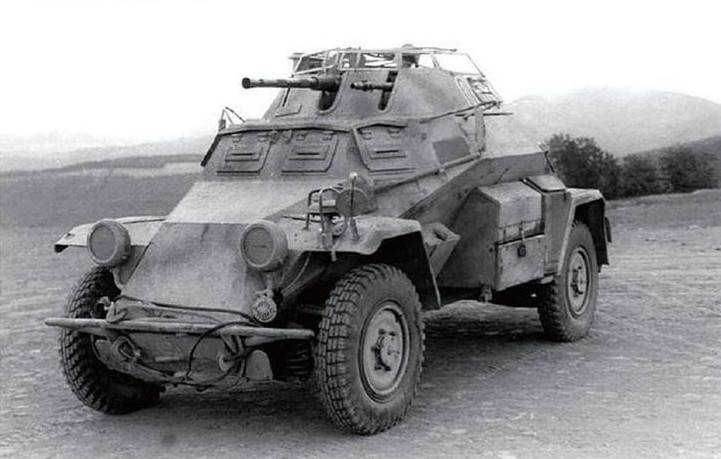
Armored car Sd. Kfz. 222
The cannon and machine gun were installed in a rotating turret and could be aimed in a vertical plane in the range from –7° to +80°, making it possible to fire at aerial targets. The rate of fire of the automatic cannon was 280 rounds per minute, and that of the machine gun was 900 rounds per minute. When firing at aircraft, the protective wire screens were folded back.
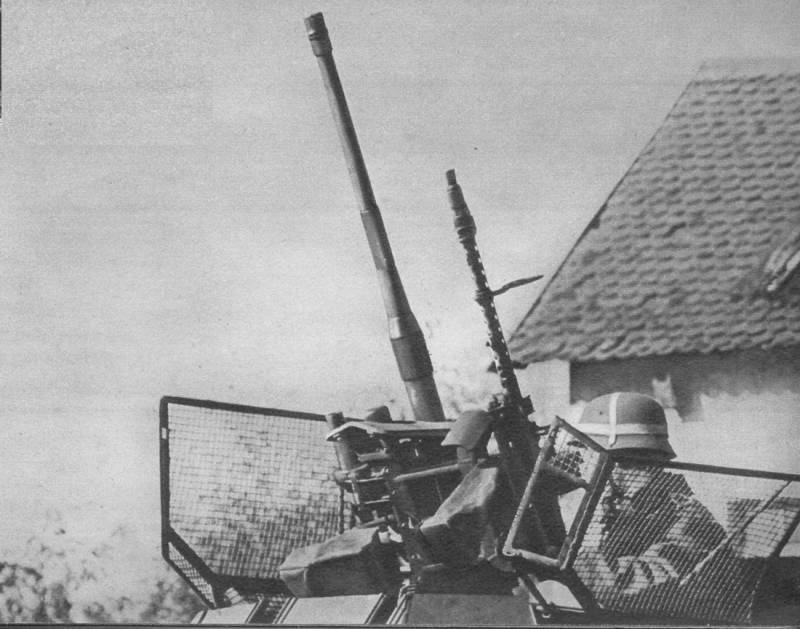
The KwK 30 automatic cannon used 20x138 mm ammunition from the FlaK 30 anti-aircraft gun. The ammunition included rounds with fragmentation tracer, fragmentation incendiary, armor-piercing tracer, armor-piercing and armor-piercing sub-caliber rounds.
An armor-piercing 20-mm projectile weighing 148 g, leaving the barrel with an initial speed of 780 m/s, at a distance of 100 m ensured penetration of 20-mm armor of medium hardness, installed at an angle of 30°. A sub-caliber projectile weighing 100 g, which had an initial speed of 1 m/s, penetrated 050 mm armor under the same conditions. With such armor penetration characteristics, the 40-mm cannon could hit light and, in some cases, medium tanks at close ranges.
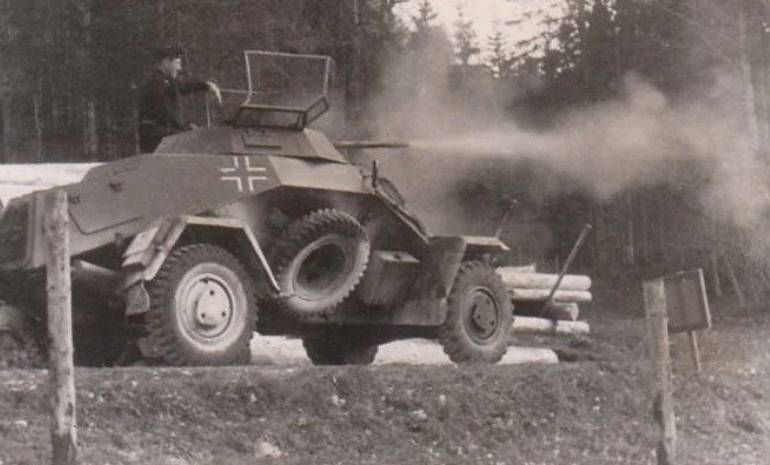
The standard carried ammunition consisted of 200 rounds for a 20-mm cannon and 1 rounds for a machine gun, but in practice the crew could take with them about 050% more ammunition, since there was a lot of free space in the armored car. However, in this case, 50 mm and 7,92 mm cartridges were transported in boxes, and it took time to equip them with belts and magazines.
The first modification, known as Sd. Kfz. 222 Ausf. A, produced from 1938 to 1941. With a total mass of 4 kg, the vehicle in the frontal view was covered with 800 mm armor, the thickness of other parts of the hull was 14,5–5 mm.
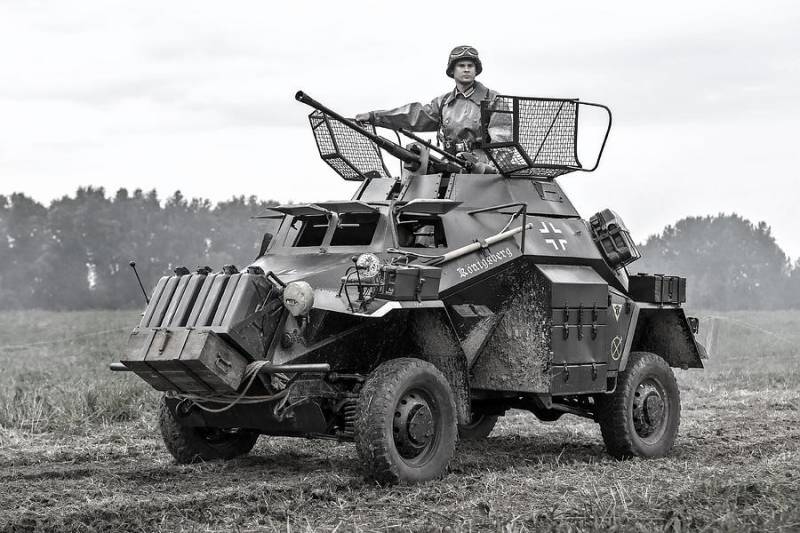
Armored car Sd. Kfz. 222, prepared for a long march
3,5-liter 8-cylinder carburetor liquid-cooled engine producing 75 hp. With. on the highway the armored car accelerated to 70 km/h. The range on a paved road reached 300 km, on a dirt road – 180 km. Crew – 3 people. On later modifications with reinforced armor, 3,8-liter engines with a power of 90 hp were installed. With.
A later version, designated Sd. Kfz. 222 Ausf. B, produced until 1944. The main differences from the earlier modification were greater security and improved weapons. In addition to a more powerful engine, the car was equipped with hydraulic brakes.
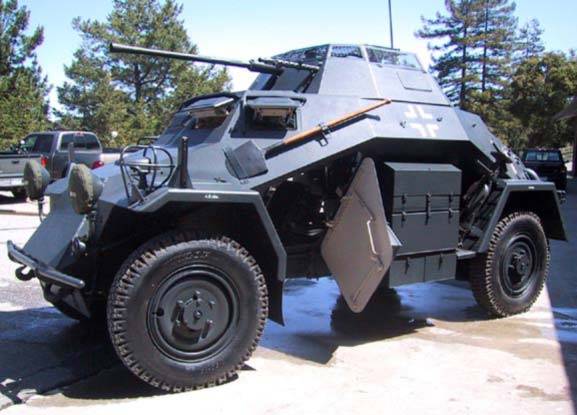
Armored car Sd. Kfz. 222 Ausf. IN
The frontal armor was increased to 30 mm, which made it possible to withstand fire from 12,7 mm armor-piercing bullets. The improved 20 mm 2 cm KwK 38 L/55 gun had a rate of fire of 480 rounds/min, but the ballistic characteristics remained the same.
To fire at ground targets, a TZF 3a telescopic sight was used; the cannon and coaxial machine gun were aimed at aircraft using the Fligerviseer 38 anti-aircraft gun. The maximum vertical aiming angle reached +87°, which, combined with an increased rate of fire, increased the capabilities of combating air targets .
In total, the German industry produced 994 Sd armored vehicles. Kfz. 222, which were actively used throughout the war. Most of the light wheeled armored vehicles were supplied to the reconnaissance units of light and tank divisions. In accordance with the current staffing schedule of 1939, the reconnaissance battalion was supposed to have two companies of armored vehicles. Subsequently, light armored vehicles were very often transferred to reconnaissance units of infantry and motorized divisions, and were also used for communications, patrolling, and as advanced artillery fire spotter vehicles.
At the first stage of World War II, light armored vehicles Sd. Kfz. 222 operated generally successfully and were fully consistent with their purpose. However, on the Eastern Front, four-wheel drive and toothy tires did not always cope with Russian mud.
The relatively high specific pressure on the ground led to the fact that wheeled vehicles were often unable to move outside of hard roads, and reconnaissance units were unable to cope with the task. In winter, deep snowdrifts turned out to be an insurmountable obstacle for wheeled armored cars.
In this regard, in 1942, reconnaissance units operating in the East began to be equipped with Sd. half-track armored personnel carriers. Kfz. 250/9, which were equipped with the same turret as the Sd. Kfz. 222, but were distinguished by much better off-road performance.
Operation of armored vehicles Sd. Kfz. 222 in the armed forces of other states
In 1938, the Chinese government bought 15 Pz light tanks from Germany. Kpfw. I Ausf. A, as well as 18 wheeled armored vehicles Sd. Kfz. 221 and 12 Sd. Kfz. 222.
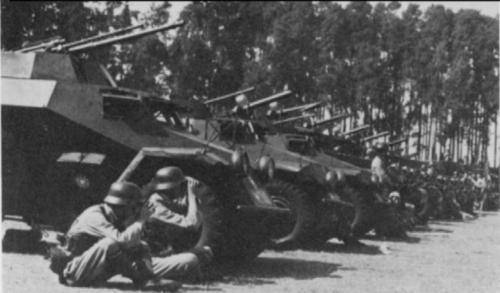
Armored vehicles with 20-mm cannons entered the 3rd Armored Battalion, formed in Nanjing. This unit also had Italian CV33 wedges. German-made armored vehicles actively fought with the Japanese, and, according to available archival materials, they remained in service in 1944.
Bulgaria received 17 Sd armored vehicles. Kfz. 222 and three Sd. Kfz. 223 (was armed with a 7,92 mm machine gun, equipped with radio stations and was used to control troops), which took part in battles with Yugoslav partisans on the territory of Macedonia.
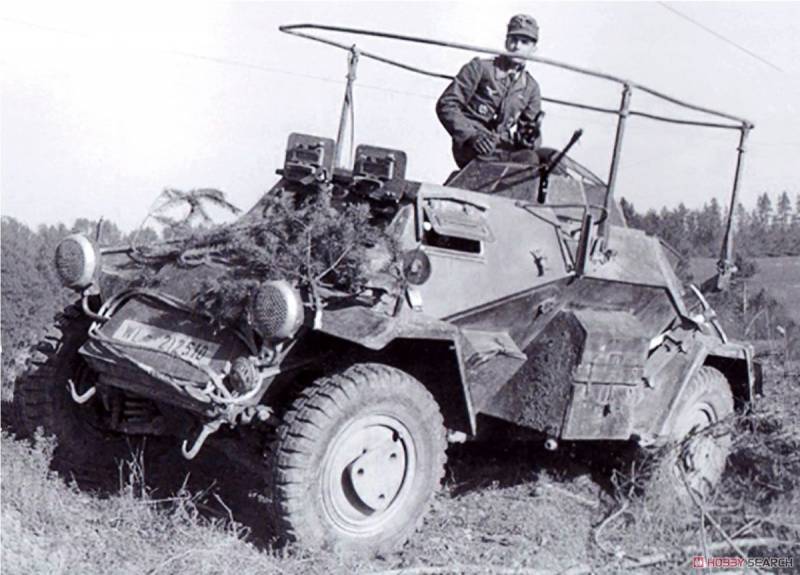
Armored car Sd. Kfz. 223
After Bulgaria joined the anti-Hitler coalition in the fall of 1944, Sd. armored vehicles. Kfz. 222 were used in combat against the Nazis.
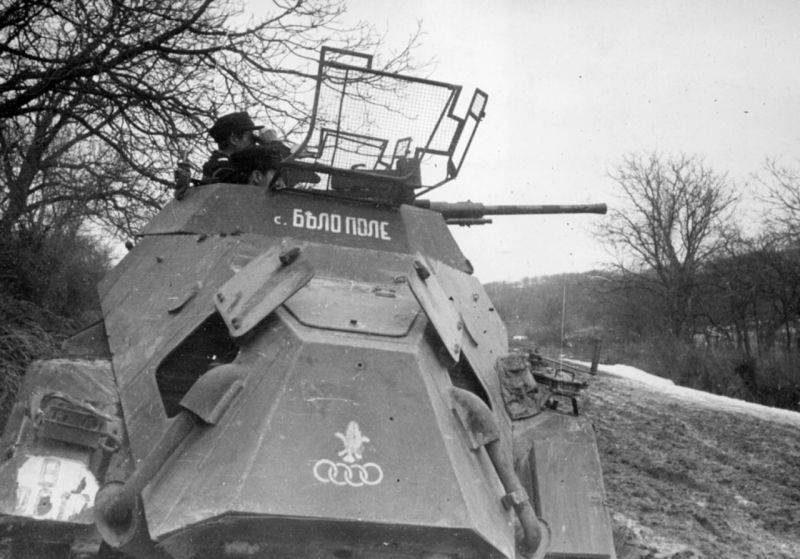
German-made armored cars that survived the battles with the Wehrmacht were used by the Bulgarian army until the end of the 1940s.
In the summer of 1941, British troops captured four serviceable Sd armored vehicles. Kfz. 222 Ausf. A in North Africa.
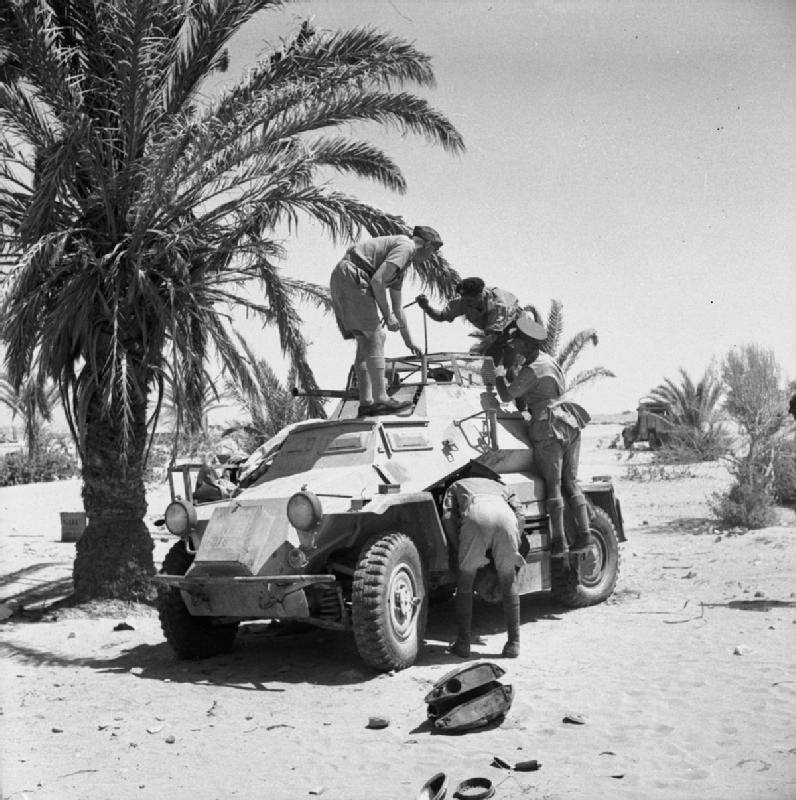
British soldiers inspect a captured armored car Sd. Kfz. 222
At least two armored cars Sd. Kfz. 222 until 1947 were at the disposal of the British military contingent stationed in Palestine.
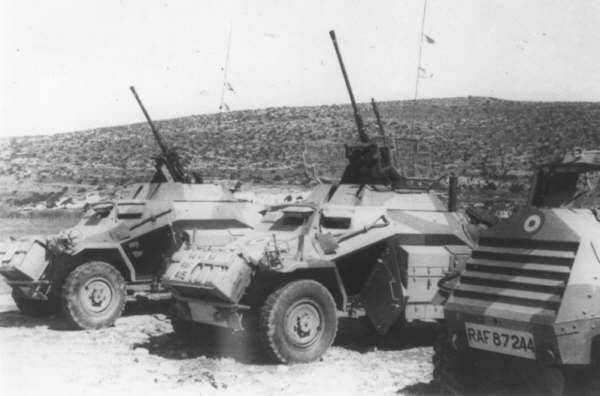
Captured armored vehicles guarded military bases and were used for patrols along with vehicles produced in England.
The Red Army captured a number of light German wheeled armored cars, which is confirmed by photographs.
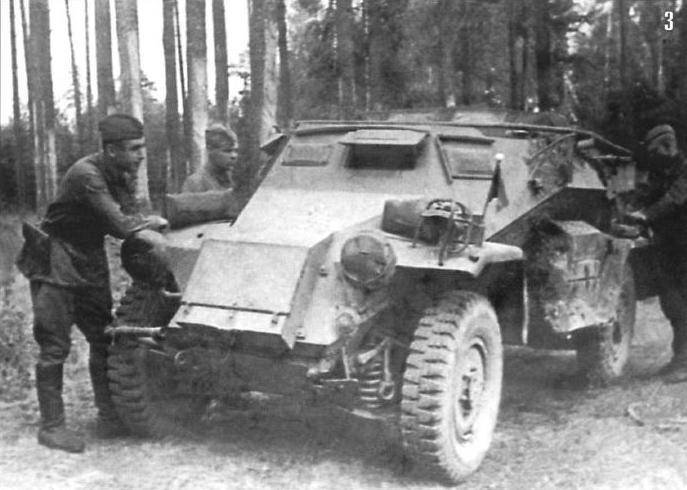
However, information on the regular use of these armored vehicles could not be found. Captured armored vehicles could be used in the Red Army for patrolling, guarding rear roads and communications. But their constant operation was hampered by a lack of spare parts.
After the end of World War II, several dozen serviceable or repairable Sd armored vehicles. Kfz. 222 remained on the territories of countries liberated from German occupation, and until the early 1950s they were used to a limited extent in the armed forces and police forces of Denmark, Norway and France. Subsequently, towers with 20-mm automatic cannons strengthened the long-term fortifications of anti-landing defense on the coast.
Apparently, armored vehicles Sd. Kfz. 222 participated in the 1948 Arab-Israeli War.
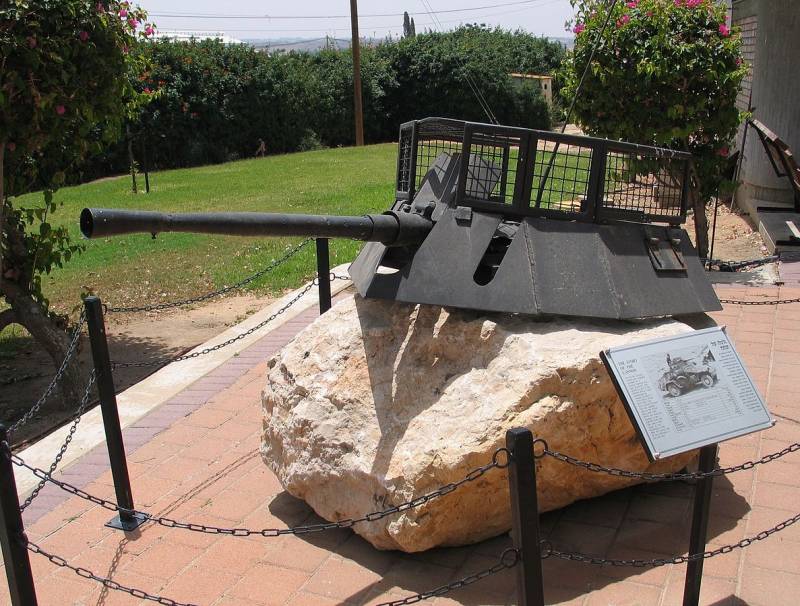
Turret of armored car Sd. Kfz. 222 at the Yad Mordechai memorial site
Currently the tower from Sd. Kfz. 222 is on display at the memorial complex dedicated to the battle for Kibbutz Yad Mordechai, located in southern Israel.
It is known that in the 1960s at least one turret, dismantled from an Sd armored car. Kfz. 222 was installed on an armored train guarding French communications in Southeast Asia. The armament of this armored train also included 7,62–12,7 mm machine guns, 40 mm automatic cannons and 81 mm mortars.
Light half-track armored personnel carrier Sd. Kfz. 250
Half-track armored transporters of the Second World War are as typical examples of German armored vehicles as the Pz tank. Kpfw. IV or self-propelled gun StuG III.
One of the most common was the light armored personnel carrier Sd. Kfz. 250 (German: Sonderkraftfahrzeug 250 - special vehicle 250), on the basis of which vehicles for various purposes were also created.
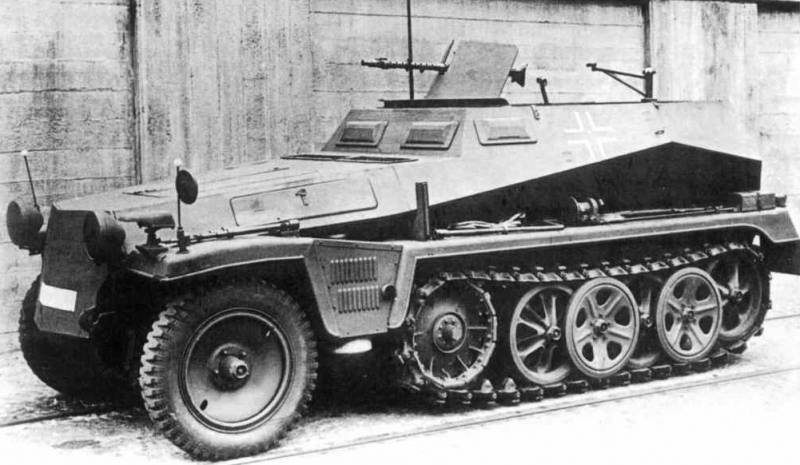
Armored personnel carrier Sd. Kfz. 250/1 early modification
Armored personnel carrier Sd. Kfz. 250, created by Bussing-NAG (armored hull) and Demag (chassis) on the basis of the half-track artillery tractor Sd. Kfz. 10 could carry half a rifle squad (4 people) and was intended primarily for use in reconnaissance units. The crew of the vehicle consisted of two people: a driver and a commander. The driver controlled the armored personnel carrier using automobile controls - a steering wheel and three standard pedals - clutch, gas and brake. To make sharp turns, levers were used, with one track slowing down and the other turning faster.
Serial production took place at the Bussing-NAG, Weserhutte, Wumag, Wegmann, Ritscher and Deutsche Werke factories. From June 1941 to March 1945, 7 units were manufactured. The armored personnel carrier was produced in two versions, the so-called old (alt) and new (neu). For the neu version, the body had a simpler design and was assembled from fewer parts (326 parts instead of 9 in the alt version). The first production Sd. Kfz. 19 began to enter the troops in July-August 250. Light armored personnel carriers Sd. Kfz. 1941 different modifications took part in the fighting until the surrender of Germany.
Armored personnel carrier Sd. Kfz. 250/1 had a combat weight of 5 kg. The chassis consisted of a steerable vehicle axle in the front of the vehicle and a tracked propulsion unit. The tracked undercarriage of each side consisted of five road wheels on a torsion bar suspension, the last roller was a guide, as well as a drive wheel in the front. All road wheels had a rubber band.
The light armored personnel carrier had good mobility. Maybach HL 42 TUKRM carburetor engine with a volume of 4,171 liters and a power of 100 hp. With. on the highway he could accelerate the car to 70 km/h. The speed of movement on virgin soil did not exceed 25 km/h. Power reserve – up to 450 km.
Front Sd. Kfz. 250 was covered with 14,5 mm thick armor plates, the side was 8 mm thick, and the stern was protected by 10 mm armor. The fighting compartment of the armored personnel carrier was open at the top. There was a steel roof only over the commander's and driver's seats. To protect the landing force from bad weather, a canvas awning was installed over the fighting compartment.
The armament consisted of 1–2 machine guns of rifle caliber MG 34 or MG 42. One machine gun with an armored shield was installed above the roof of the control compartment, the other in the rear of the hull on a swivel mount, allowing firing at large elevation angles. The ammunition load was 2 rounds.
In addition to the basic infantry modification, the following production variants existed:
Sd. Kfz. 250/2 – armored cable layer for laying field communication lines. The reel with the telephone cable was located inside the body. Crew – 4 people. Armament – 1 MG 34 machine gun.
Sd. Kfz. 250/3 – communication machine. Depending on the purpose, it was equipped with FuG 7, FuG 8 or FuG 12 radio stations with whip or loop antennas.
Sd. Kfz. 250/4 and Sd. Kfz. 250/5 – observation and fire control vehicles for self-propelled artillery. Radio stations FuG 15 and FuG 16 or one FuG 12. The crew consisted of 4–5 people. Armament – 1 MG 34 machine gun.
Sd. Kfz. 250/6 – a vehicle for transporting ammunition for assault guns. It could hold 60–70 rounds for a 75 mm cannon. Crew – 2 people. Armament – 1 MG 34 machine gun.
Sd. Kfz. 250/7 – self-propelled 81-mm mortar (carrying 12 rounds of ammunition). Crew – 5 people. Additional weapons – 1 MG 34 machine gun.
Sd. Kfz. 250/8 is a fire support vehicle armed with a short-barreled 75 mm cannon. Ammunition - 20 shots.
Sd. Kfz. 250/9 – armored reconnaissance armored vehicle. A turret from an Sd armored car was installed. Kfz. 222 (later replaced by the Hangelafette 38 turret) with a 20 mm KwK 38 automatic cannon and an MG 34 machine gun.
Sd. Kfz. 250/10 - an armored personnel carrier armed with a 37-mm Pak 35/36 cannon mounted in the front of the body and an MG 34 machine gun. Ammunition - 216 rounds and 2 rounds of ammunition. Crew – 100 people.
Sd. Kfz. 250/11 - an armored personnel carrier armed with a heavy anti-tank rifle sPzB 41 caliber 20-28 mm with a conical barrel and an MG 34 machine gun (ammunition capacity of 168 rounds and 1 rounds).
Sd. Kfz. 250/12 – artillery instrumental reconnaissance vehicle. Radio station FuG 8, later FuG 12. Armament – 1 MG 34 machine gun.
Sd. Kfz. 252 – ammunition transporter for StuG III / StuG IV assault guns. A completely enclosed armored hull with a strongly beveled rear plate. Crew – 2 people.
Sd. Kfz. 253 is a vehicle for platoon and battery commanders of assault guns with a completely enclosed hull. Radio stations F. Sp. H and FuG 7. Crew – 3 people.
In addition to modifications made in factories, there were variants converted from linear armored personnel carriers in military workshops. The most famous of them are vehicles armed with the French Hotchkiss SA-L 25 mm anti-tank gun, the Pak 50 anti-tank 38 mm gun, and the Flak 20 and Flak 30 anti-aircraft 38 mm cannons. A number of Sd. Kfz. 250 were converted into ambulances.
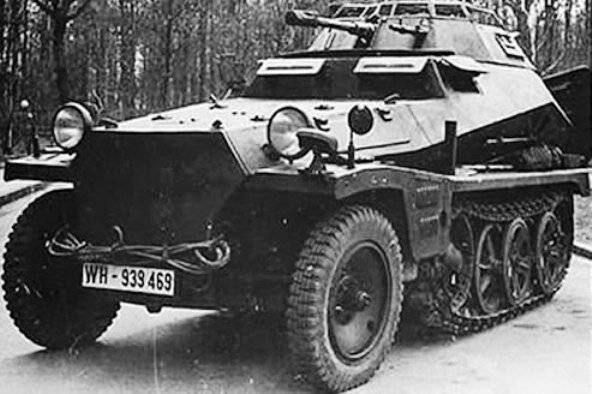
Armored reconnaissance vehicle Sd. Kfz. 250/9
Armored personnel carriers Sd. Kfz. 250 and special vehicles based on them were in service with motorized units, in units of signal troops and assault artillery. For example, in 1944, the Wehrmacht tank division was assigned 55 light armored personnel carriers. Machines Sd. Kfz. 250/8 were used in motorized infantry units for fire support, and the Sd. Kfz. 250/10 and Sd. Kfz. 250/11 - as commanders.
As of March 1, 1945, the German armed forces had 2 light half-track armored vehicles.
Operation of armored personnel carriers Sd. Kfz. 250 in the armed forces of other states
The first operational armored personnel carriers Sd. Kfz. 250 were captured by the Red Army in the late autumn of 1941, but their regular use began in 1942.
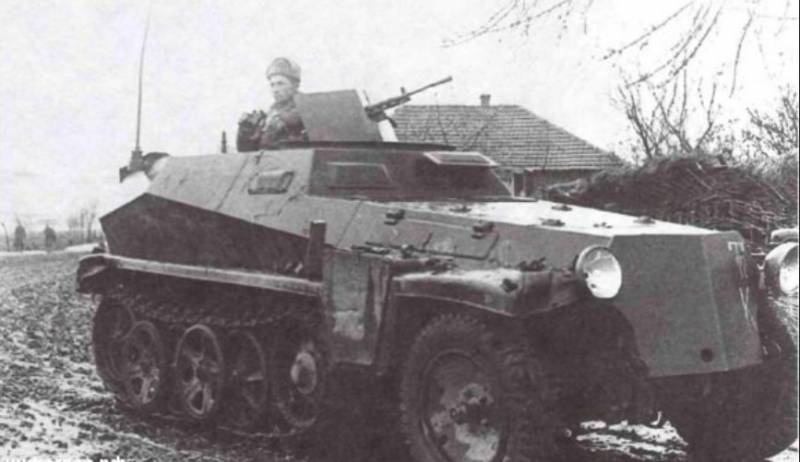
Captured armored personnel carrier Sd. Kfz. 250, used in one of the reconnaissance units of the Red Army. Mozdok area, autumn 1942
After the Red Army switched to offensive operations, the number of captured German armored vehicles increased, and captured armored personnel carriers ceased to be a rarity.
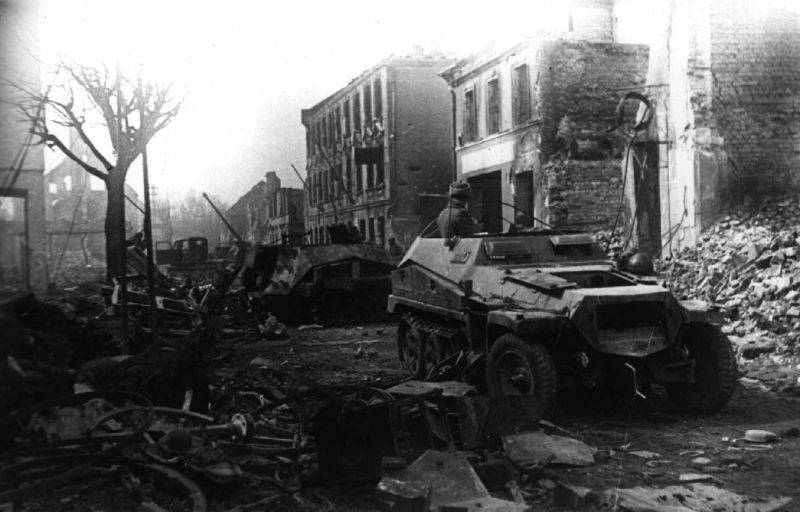
Soviet soldier in a German armored personnel carrier Sd. Kfz. 250 on one of the streets of Konigsberg
In the Red Army, at the final stage of the war, German-made light armored personnel carriers were used for reconnaissance, communication between units and to support the life of regimental and divisional headquarters.
Often captured armored personnel carriers Sd. Kfz. 250 were not documented and were operated beyond capacity. This approach simplified accounting and did not require a report in case of loss or breakdown of equipment.
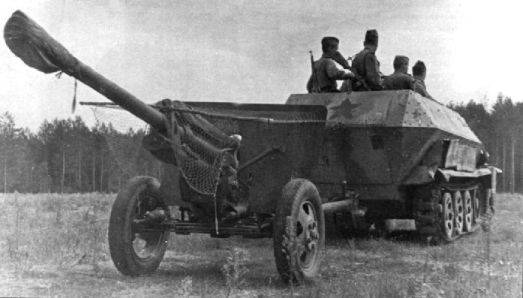
Sometimes captured armored personnel carriers were used as repair missions or tractors for artillery guns of 45–76 mm caliber.
Armored personnel carriers Sd. Kfz. 250 served in units of the Red Army stationed in the territories of European states liberated from the Nazis until the end of 1946.
The American armed forces were well stocked with their own armored personnel carriers. However, there is a lot of evidence that the US Army willingly used vehicles captured from the enemy.
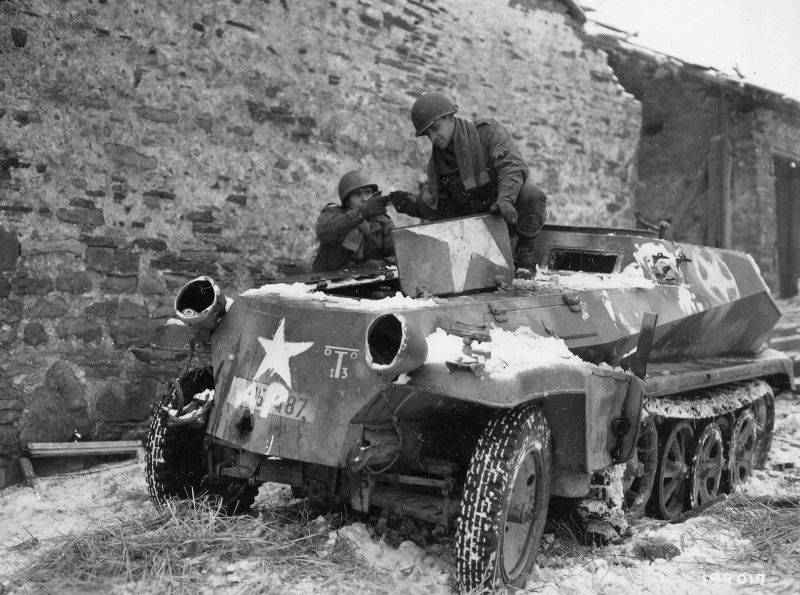
Soldiers of the 334th Regiment of the 84th Infantry Division of the United States are trying to repair a German armored personnel carrier Sd. Kfz. 250 captured by the Allies at Samre, Belgium
In a number of cases, American soldiers deliberately restored damaged or broken German half-track armored personnel carriers that they managed to capture.
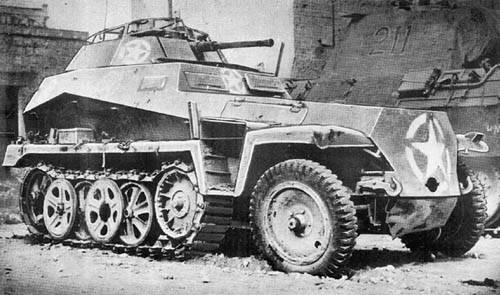
Thanks to their high cross-country ability and good mobility, captured German BRM Sd. Kfz. 250/9 were in demand in American reconnaissance units.
A significant amount of Sd. Kfz. 250 remained on the territory of Czechoslovakia after the surrender of German troops.
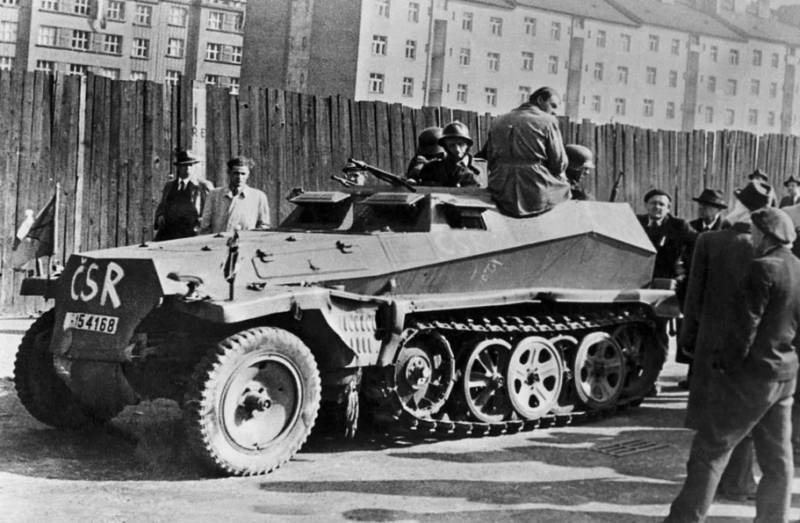
Armored personnel carrier Sd. Kfz. 250, captured during the Prague Uprising
In the post-war period, the Czechoslovak army very willingly used equipment and weapons inherited from the Third Reich. But the armored personnel carrier Sd. Kfz. The 250 was an exception in this regard.
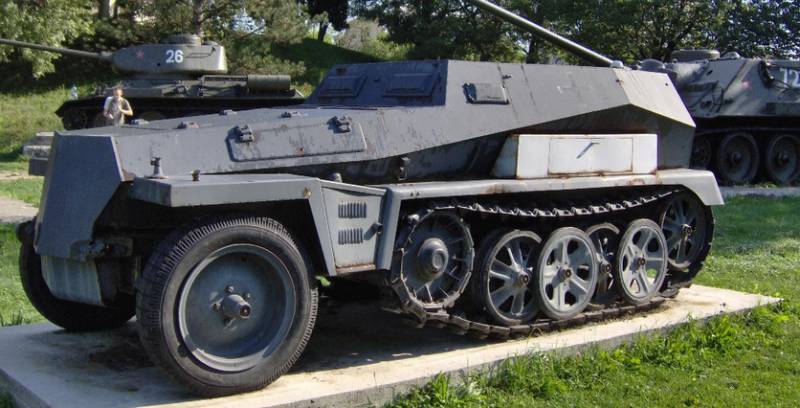
Armored personnel carrier Sd. Kfz. 250 in the Slovak Military History Museum of Svidnik
Unlike most other German-made armored vehicles, light half-track armored personnel carriers were decommissioned in Czechoslovakia in the late 1940s.
The same thing happened in other European countries, where serviceable Sd remained. Kfz. 250. After the end of hostilities, the armed forces of the states that came under the influence of the United States received American-made armored cars and armored personnel carriers, of which a lot were produced. In conditions of shortage of spare parts, difficulties with maintenance and repair, the light Sd. Kfz. 250, which had a small carrying capacity, turned out to be unclaimed and for the most part were cut into metal.
Half-track armored personnel carrier Sd. Kfz. 251
The most famous German armored personnel carrier of the Second World War is the Sd. Kfz. 251, which is often referred to as “Hanomag” - after the name of the manufacturer Hanomag (Hannoversche Maschinenbau AG).
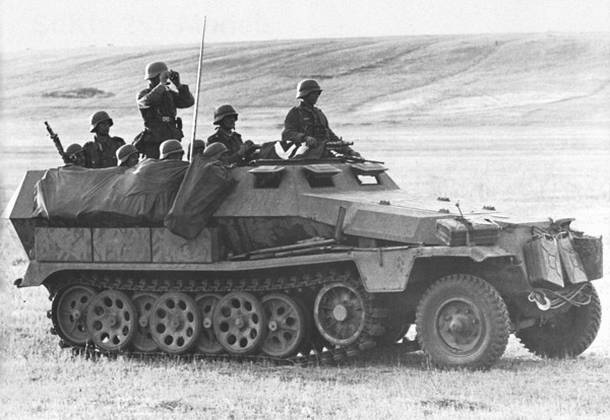
Armored personnel carrier Sd. Kfz. 251/1 Ausf. C
Armored personnel carrier Sd. Kfz. 251 was created in 1938 on the basis of the artillery three-ton half-track tractor Sd. Kfz. 11 and was mass-produced from June 1939 to March 1945. The industry of the Third Reich managed to deliver more than 15 half-track armored vehicles of the Sd. family. Kfz. 000 in various versions. The first production Sd. Kfz. 251 were baptized by fire during the Polish campaign.
As in the case of the light armored personnel carrier Sd. Kfz. 250, the chassis of the vehicle used tracks with external rubber cushions, a front axle with steered wheels and a staggered arrangement of road wheels. The transmission of the armored personnel carrier used an automobile four-speed gearbox. Control was carried out by turning a car-type steering wheel. When turning at a small angle, the turn was carried out only through the use of the front wheels. For a sharper turn, the driver used tracks.
Armored personnel carriers Sd. Kfz. 251 had four production modifications: Ausf. A, B, C and D, as well as special variants that differed from each other in weapons and equipment.
The main one was the Sd armored personnel carrier. Kfz. 251/1. This combat vehicle, put into service in 1940, was intended to transport an infantry squad (10 people), its own crew consisted of a commander and a driver. The main specialization of the armored personnel carrier was the transportation of motorized infantry (panzergrenadiers).
To combat enemy infantry and air targets, 1–2 MG 34 machine guns (at the end of the war MG 42) with a total ammunition load of up to 2 rounds were installed. The machine gun in the front part of the hull was covered with an armored shield, and located in the rear of the vehicle was mounted on a swivel mount.
The armored hull on the first models was riveted, later it became completely welded and was assembled from rolled armor plates located at rational angles of inclination with a thickness of 6 mm (bottom) to 14,5 mm (forehead). On average Sd. Kfz. 251 was equipped with the same engine as on the light Sd. Kfz. 250. Taking into account the fact that the combat weight of Sd. Kfz. 251 was 9 kg, the maximum speed on the highway did not exceed 140 km/h. Power reserve – up to 53 km.
The half-track propulsion system provided the vehicle with the ability to overcome inclines up to 24°, ditches up to 2 m wide and fords up to 1,5 m deep without any preparation.
Based on the armored personnel carrier Sd. Kfz. 251/1, the following special vehicles were created and mass-produced:
Sd. Kfz. 251/2 – self-propelled 81-mm mortar (66 rounds of ammunition), 1 7,92-mm machine gun. Crew – 8 people.
Sd. Kfz. 251/3 – armored command and staff vehicle. Depending on the purpose, it was equipped with radio stations FuG 4, FuG 5, FuG 7, FuG 8, FuG 11 and FuG 12 in various combinations.
Sd. Kfz. 251/4 – ammunition transporter and tractor for towing 75 mm light infantry guns, 105 mm light field howitzers and 37–75 mm anti-tank guns. Crew – 7 people. Armament – 1 MG 34 machine gun.
Sd. Kfz. 251/5 and Sd. Kfz. 251/7 - armored vehicles for transporting sappers and equipment attached to them. Crew - 9 people, weapons - 1 MG 34 machine gun.
Sd. Kfz. 251/6 – divisional, corps and army level KShM. Radio stations FuG 11 and FuG Tr, later FuG 19 and FuG 12.
Sd. Kfz. 251/8 - armored vehicle for evacuation of the wounded.
Sd. Kfz. 251/9 – self-propelled gun with a short-barreled 7,5 cm K 37 cannon (later 7,5 cm K 51). Crew - 5 people, additional weapons - 1 MG 34 or MG 42 machine gun. This self-propelled gun was often used as an armored reconnaissance vehicle or for fire support of infantry.
Sd. Kfz. 251/10 – vehicle for platoon commanders in motorized infantry units. Armament: 37 mm Pak 35/36 anti-tank gun and MG 34 machine gun. Crew - 5 people.
Sd.Kfz. 251/11 – machine for laying telephone cables. Crew: 5 people, armament: 1 MG 34 machine gun.
Sd.Kfz. 251/12 – artillery reconnaissance and fire control vehicle. Radio station FuG 8 with loop antenna. Crew – 6 people.
Sd. Kfz. 251/13 and Sd. Kfz. 251/14 – artillery sound reconnaissance vehicles. Crew – 8 people.
Sd. Kfz. 251/15 – optical reconnaissance vehicle.
Sd. Kfz. 251/16 – self-propelled flamethrower. Armament: two flamethrowers and two MG 34 machine guns. Fire mixture reserve - 700 liters (for 80 two-second shots). Flame throwing range – up to 35 m (depending on wind direction).
Sd. Kfz. 251/17 - anti-aircraft self-propelled gun with a 20-mm Flak 38 automatic cannon. Ammunition - 600 rounds. Crew: 4–6 people.
Sd. Kfz. 251/18 – surveillance and communications vehicle. Radio station FuG 8. Crew – 6 people.
Sd. Kfz. 251/19 – mobile telephone exchange.
Sd. Kfz. 251/20 – self-propelled infrared searchlight. The commander of an armored personnel carrier with an IR spotlight at night controlled the actions of a Panther platoon (5 tanks) using the FuG 5 radio station. The crew was 4 people.
Sd. Kfz. 251/21 – ZSU with three 20-mm automatic cannons MG 151/20 or MG 151/15 of 15 mm caliber. Crew – 6 people.
Sd. Kfz. 251/22 – tank destroyer with a 75-mm Pak 40/1 anti-tank gun behind a standard shield in the front of the body. Crew 4 people.
Armored personnel carriers Sd. Kfz. 251 and special vehicles created on its basis were actively used by the Wehrmacht and SS troops throughout the Second World War.
Operation of armored personnel carriers Sd. Kfz. 251 in the armed forces of other states
Taking into account the mass production of armored personnel carriers Sd. Kfz. 251 and vehicles for various purposes created on its basis, they often became trophies of the Red Army and American-British troops.
Soviet industry did not produce armored personnel carriers during wartime. In the second half of the war, the allies supplied a noticeable number of armored personnel carriers, but given the scale and intensity of the fighting, there was always a shortage of imported armored transporters.
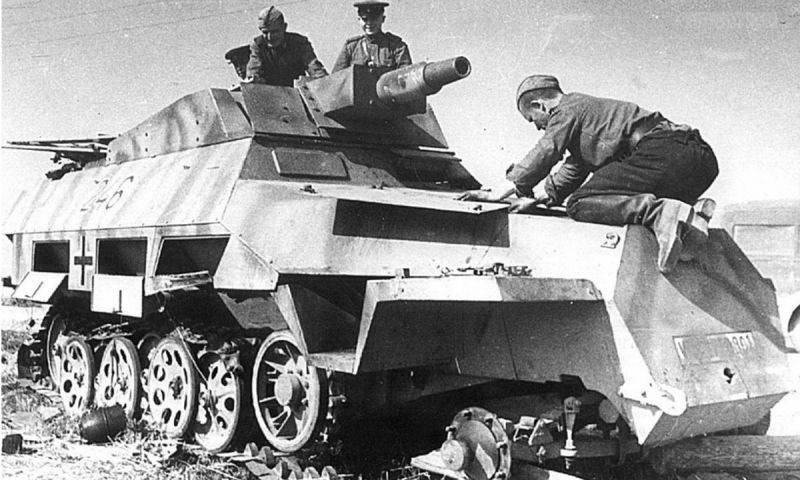
Red Army soldiers inspect a faulty German BRM Sd. Kfz. 251/9, summer 1943
Under the current conditions, Red Army soldiers willingly used captured equipment, often repairing faulty vehicles that had been damaged and abandoned by the enemy.
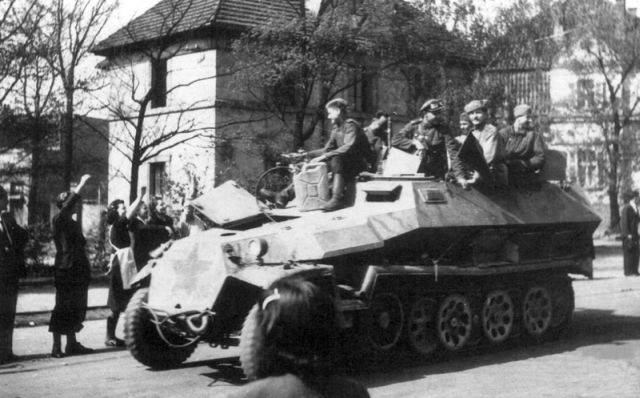
In addition to the widespread armored personnel carriers, platoon commander vehicles and armored reconnaissance vehicles, Red Army soldiers sometimes captured relatively rare Sd tank destroyers. Kfz. 251/22 with a 75 mm Pak 40/1 anti-tank gun.
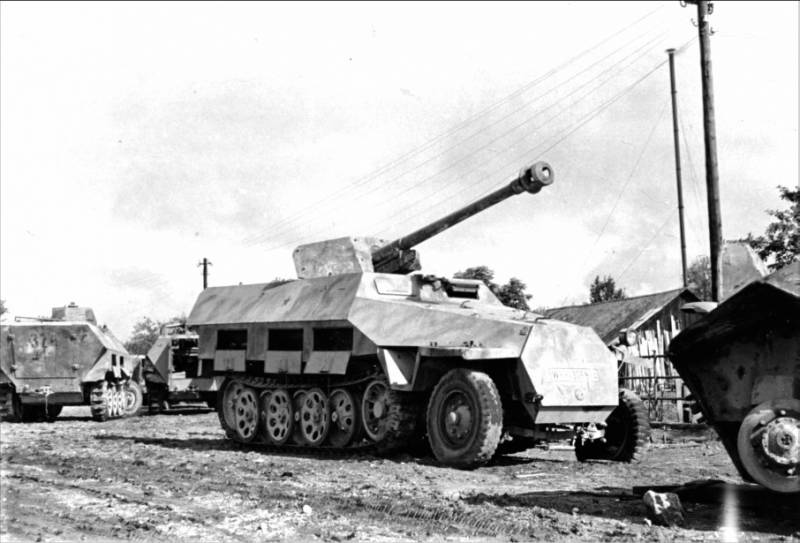
There are also photographs indicating the active use of Sd. Kfz. 251 in the US military.
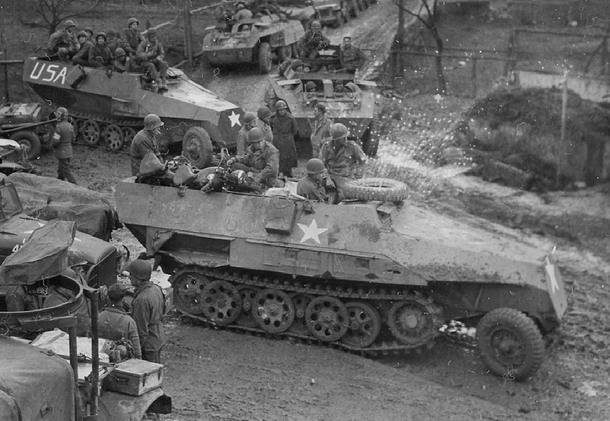
At least one medium armored personnel carrier fell into Polish hands and was used during the Warsaw Uprising in August 1944.
After the liberation of Western European countries from the Nazis, the Allies transferred captured armored personnel carriers to the newly formed local armed and police forces.
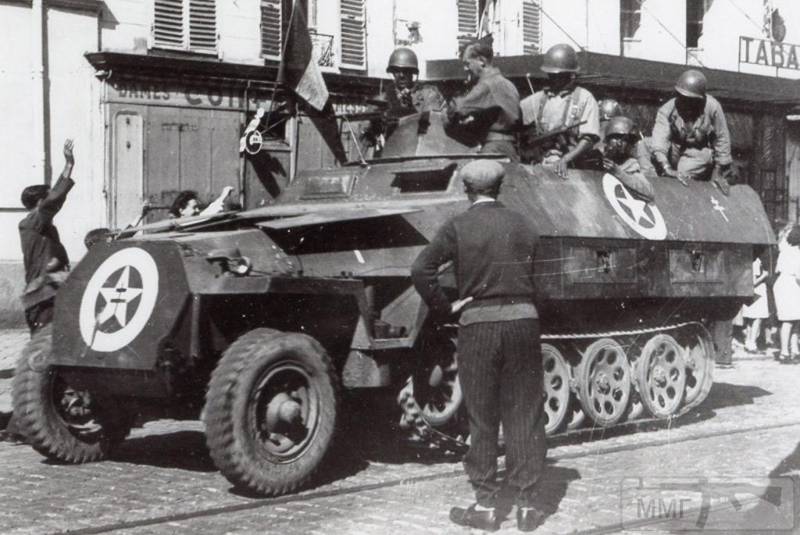
Thus, in France, German-made armored personnel carriers, along with other captured armored vehicles, were used until the first half of the 1950s.
The longest-lasting half-track armored vehicles are the Sd. Kfz. 251 operated by Czechoslovakia. This is due to the fact that during the Second World War, the Czech enterprises Hermann-Göring-Werke (Škoda) and Tatra-Werke AG produced them. Naturally, specialists, technological equipment, and a stock of components and spare parts remained at local factories.
In the Czechoslovak army, the original German-style armored personnel carriers were designated HKL-6p Hakl. As of 1951, there were 736 German armored personnel carriers in active service. By 1957, their number had decreased to 630 units.
After undergoing a major overhaul, these vehicles received the designation OPp3N (armored half-track, 3 tons, German) and served in the border guard for approximately 10 years, after which they were replaced by the Tatra OT-810 armored personnel carrier.
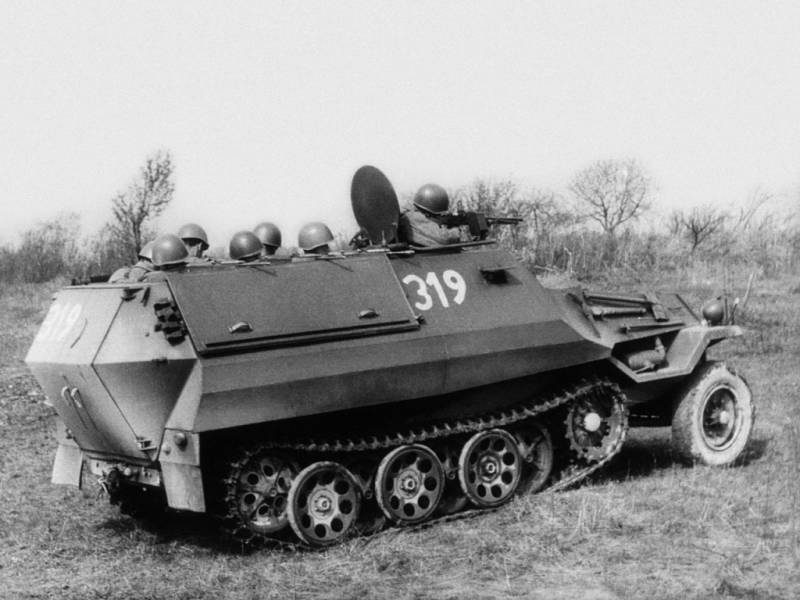
OT-810 armored personnel carrier
The Czechoslovak armored personnel carrier differed from its German prototype by a new air-cooled diesel engine Tatra T-928-3 with a power of 120 hp. With. This engine was created under the Germans, but was mass-produced in the post-war period. The OT-810 was also equipped with an improved chassis and an armored roof that could be hinged. With a diesel engine, the range has doubled, reaching 620 kilometers. Armament was limited to one 7,62 mm machine gun.
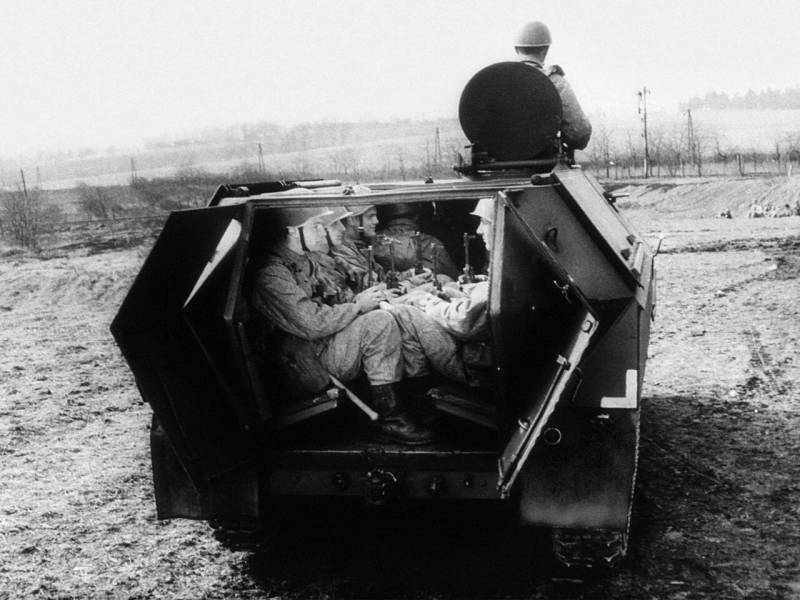
View of the troop compartment of the OT-810 armored personnel carrier
From 1959 to 1963, the Pogron Machine-Building Plant, located in Slovakia, produced about 1 armored personnel carriers, command vehicles, tank destroyers with an 800-mm recoilless rifle and a self-propelled gun with a quad 82-mm anti-aircraft machine gun mount.
The operation of OT-810 continued until the second half of the 1980s, they were in storage until the end of the 1990s.
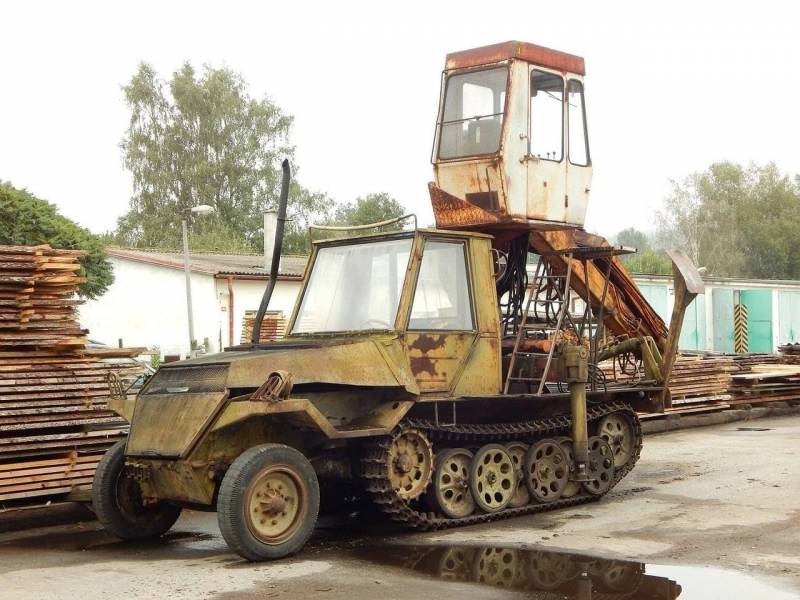
After decommissioning, a number of Czech-German armored personnel carriers were sold to private individuals and civilian organizations. In addition to collectors, museums and film studios, some of the demilitarized vehicles were converted into tractors and loader-manipulators.
Продолжение следует ...
Information